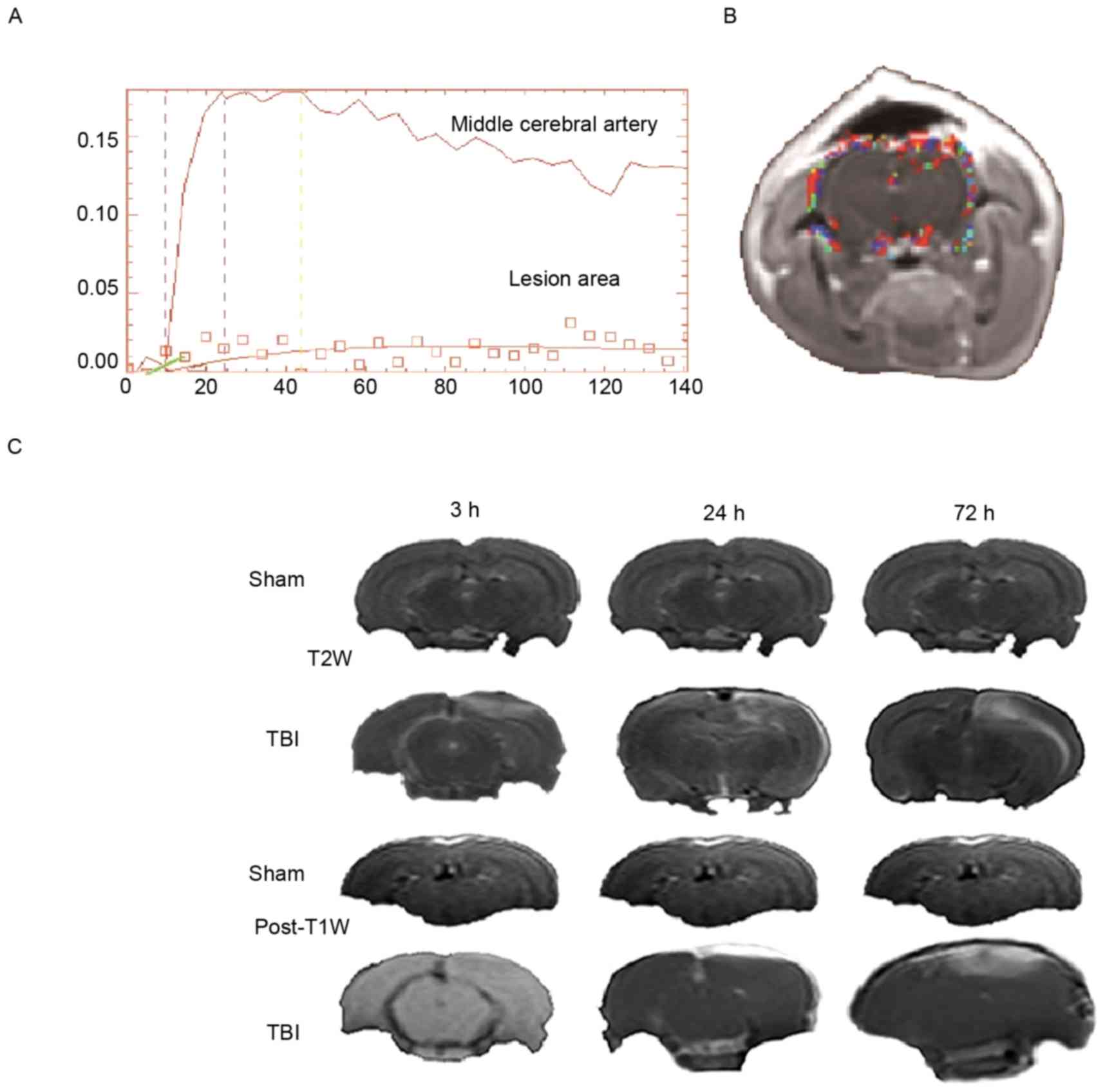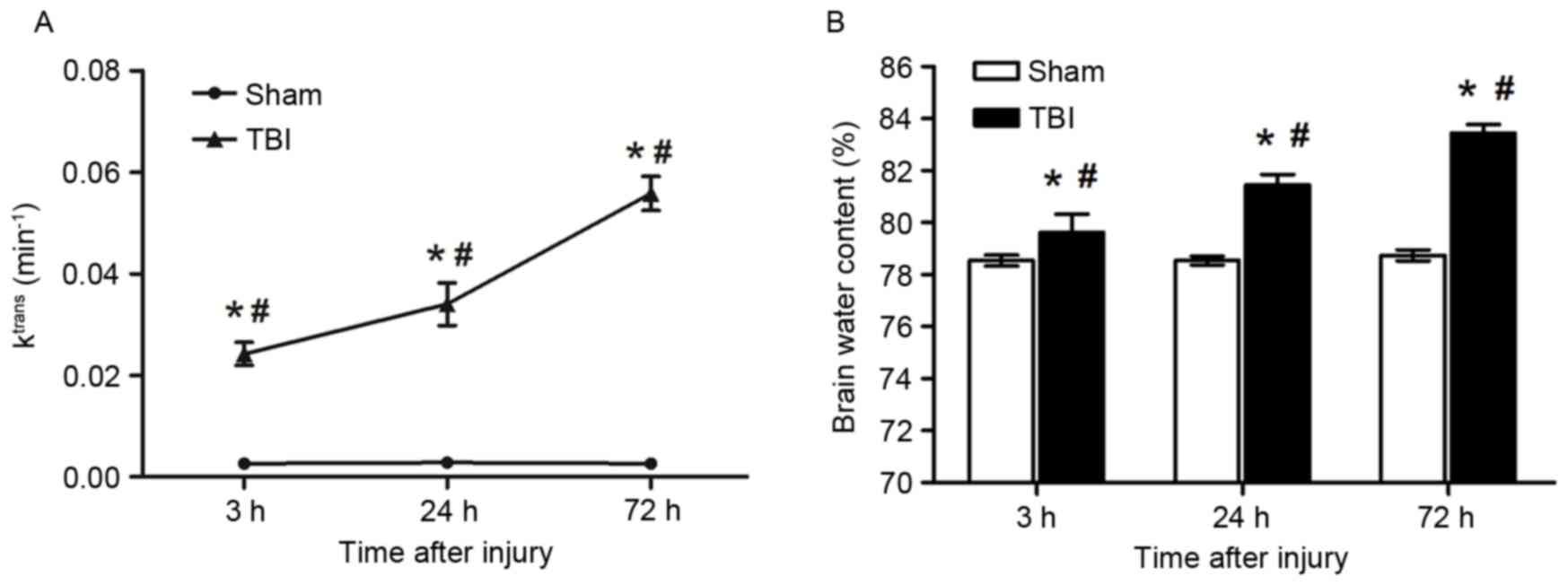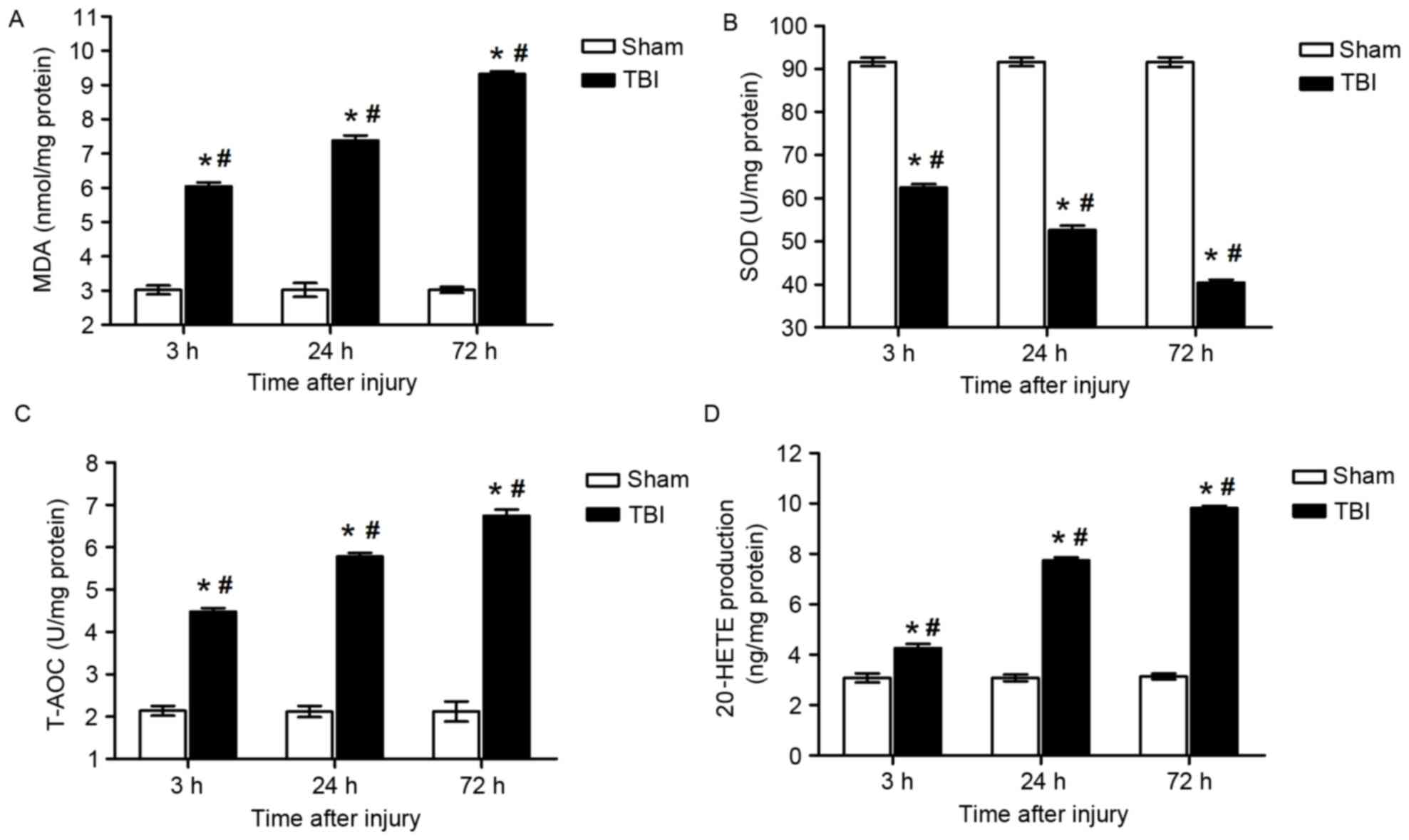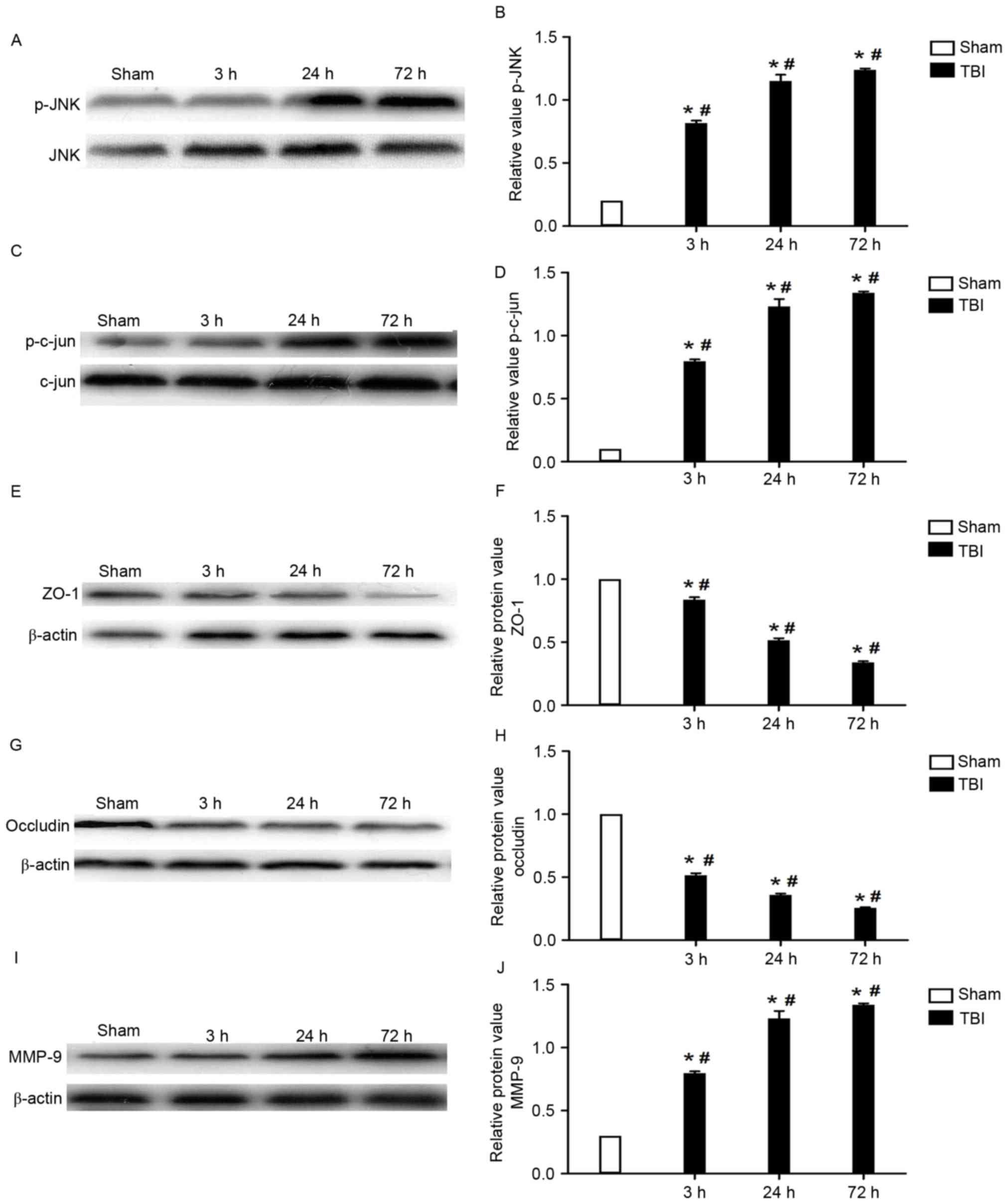|
1
|
Birnie M, Morrison R, Camara R and Strauss
KI: Temporal changes of cytochrome P450 (Cyp) and
eicosanoid-related gene expression in the rat brain after traumatic
brain injury. BMC Genomics. 14:3032013. View Article : Google Scholar : PubMed/NCBI
|
|
2
|
Yang S, Ma Y, Liu Y, Que H, Zhu C and Liu
S: Arachidonic acid: A bridge between traumatic brain injury and
fracture healing. J Neurotrauma. 29:2696–2705. 2012. View Article : Google Scholar : PubMed/NCBI
|
|
3
|
Johnson AL, Edson KZ, Totah RA and Rettie
AE: Cytochrome P450 ω-hydroxylases in inflammation and cancer. Adv
Pharmacol. 74:223–262. 2015. View Article : Google Scholar : PubMed/NCBI
|
|
4
|
Harder DR, Gebremedhin D, Narayanan J,
Jefcoat C, Falck JR, Campbell WB and Roman R: Formation and action
of a P-450 4A metabolite of arachidonic acid in cat cerebral
microvessels. Am J Physiol. 266:H2098–H2107. 1994.PubMed/NCBI
|
|
5
|
Zhu J, Wang B, Lee JH, Armstrong JS,
Kulikowicz E, Bhalala US, Martin LJ, Koehler RC and Yang ZJ:
Additive neuroprotection of a 20-HETE inhibitor with delayed
therapeutic hypothermia after hypoxia-ischemia in neonatal piglets.
Dev Neurosci. 37:376–389. 2015. View Article : Google Scholar : PubMed/NCBI
|
|
6
|
Garcia V, Cheng J, Weidenhammer A, Ding Y,
Wu CC, Zhang F, Gotlinger K, Falck JR and Schwartzman ML:
Androgen-induced hypertension in angiotensinogen deficient mice:
Role of 20-HETE and EETS. Prostaglandins Other Lipid Mediat.
116-117:124–130. 2015. View Article : Google Scholar : PubMed/NCBI
|
|
7
|
Toth P, Csiszar A, Sosnowska D, Tucsek Z,
Cseplo P, Springo Z, Tarantini S, Sonntag WE, Ungvari Z and Koller
A: Treatment with the cytochrome P450 ω-hydroxylase inhibitor
HET0016 attenuates cerebrovascular inflammation, oxidative stress
and improves vasomotor function in spontaneously hypertensive rats.
Br J Pharmacol. 168:1878–1888. 2013. View Article : Google Scholar : PubMed/NCBI
|
|
8
|
Wei XE, Zhang YZ, Li YH, Li MH and Li WB:
Dynamics of rabbit brain edema in focal lesion and perilesion area
after traumatic brain injury: A MRI study. J Neurotrauma.
29:2413–2420. 2012. View Article : Google Scholar : PubMed/NCBI
|
|
9
|
Cai H, Mu Z, Jiang Z, Wang Y, Yang GY and
Zhang Z: Hypoxia-controlled matrix metalloproteinase-9
hyperexpression promotes behavioral recovery after ischemia.
Neurosci Bull. 31:550–560. 2015. View Article : Google Scholar : PubMed/NCBI
|
|
10
|
Xu FF, Sun S, Ho AS, Lee D, Kiang KM,
Zhang XQ, Wang AM, Wu EX, Lui WM, Liu BY and Leung GK: Effects of
progesterone vs. dexamethasone on brain oedema and inflammatory
responses following experimental brain resection. Brain Inj.
28:1594–1601. 2014. View Article : Google Scholar : PubMed/NCBI
|
|
11
|
Kim JY, Ko AR, Hyun HW and Kang TC: ETB
receptor-mediated MMP-9 activation induces vasogenic edema via ZO-1
protein degradation following status epilepticus. Neuroscience.
304:355–367. 2015. View Article : Google Scholar : PubMed/NCBI
|
|
12
|
Wu G, Wu J, Jiao Y, Wang L, Wang F and
Zhang Y: Rosiglitazone infusion therapy following minimally
invasive surgery for intracerebral hemorrhage evacuation decreases
matrix metalloproteinase-9 and blood-brain barrier disruption in
rabbits. BMC Neurol. 15:372015. View Article : Google Scholar : PubMed/NCBI
|
|
13
|
Wang GY, Wang N and Liao HN: Effects of
muscone on the expression of P-gp, MMP-9 on blood-brain barrier
model in vitro. Cell Mol Neurobiol. 35:1105–1115. 2015. View Article : Google Scholar : PubMed/NCBI
|
|
14
|
Liu Y, Wang D, Wang H, Qu Y, Xiao X and
Zhu Y: The protective effect of HET0016 on brain edema and
blood-brain barrier dysfunction after cerebral
ischemia/reperfusion. Brain Res. 1544:45–53. 2014. View Article : Google Scholar : PubMed/NCBI
|
|
15
|
Urrutia A, Rubio-Araiz A, Gutierrez-Lopez
MD, ElAli A, Hermann DM, O'Shea E and Colado MI: A study on the
effect of JNK inhibitor, SP600125, on the disruption of blood-brain
barrier induced by methamphetamine. Neurobiol Dis. 50:49–58. 2013.
View Article : Google Scholar : PubMed/NCBI
|
|
16
|
Jungner M, Siemund R, Venturoli D,
Reinstrup P, Schalén W and Bentzer P: Blood-brain barrier
permeability following traumatic brain injury. Minerva Anestesiol.
82:525–533. 2016.PubMed/NCBI
|
|
17
|
Hanrahan F and Campbell M: Frontiers in
neuroscience neuroinflammationTranslational research in traumatic
brain injury. Laskowitz D and Grant G: CRC Press/Taylor and Francis
Group (c) 2016 by Taylor & Francis Group LLC; Boca Raton (FL):
2016
|
|
18
|
Gasche Y, Copin JC, Sugawara T, Fujimura M
and Chan PH: Matrix metalloproteinase inhibition prevents oxidative
stress-associated blood-brain barrier disruption after transient
focal cerebral ischemia. J Cereb Blood Flow Metab. 21:1393–1400.
2001. View Article : Google Scholar : PubMed/NCBI
|
|
19
|
Lapchak PA, Chapman DF and Zivin JA:
Metalloproteinase inhibition reduces thrombolytic (tissue
plasminogen activator)-induced hemorrhage after thromboembolic
stroke. Stroke. 31:3034–3040. 2000. View Article : Google Scholar : PubMed/NCBI
|
|
20
|
Gu JH, Ge JB, Li M, Xu HD, Wu F and Qin
ZH: Poloxamer 188 protects neurons against ischemia/reperfusion
injury through preserving integrity of cell membranes and blood
brain barrier. PLoS One. 8:e616412013. View Article : Google Scholar : PubMed/NCBI
|
|
21
|
Wang ZG, Cheng Y, Yu XC, Ye LB, Xia QH,
Johnson NR, Wei X, Chen DQ, Cao G, Fu XB, et al: bFGF protects
against blood-brain barrier damage through junction protein
regulation via PI3K-Akt-Rac1 pathway following traumatic brain
injury. Mol Neurobiol. 53:7298–7311. 2015. View Article : Google Scholar : PubMed/NCBI
|
|
22
|
Liu Y, Wang H and Zhu Y, Chen L, Qu Y and
Zhu Y: The protective effect of nordihydroguaiaretic acid on
cerebral ischemia/reperfusion injury is mediated by the JNK
pathway. Brain Res. 1445:73–81. 2012. View Article : Google Scholar : PubMed/NCBI
|
|
23
|
Mehta SL, Manhas N and Raghubir R:
Molecular targets in cerebral ischemia for developing novel
therapeutics. Brain Res Rev. 54:34–66. 2007. View Article : Google Scholar : PubMed/NCBI
|
|
24
|
Yu W, Chen L, Yang YQ, Falck JR, Guo AM,
Li Y and Yang J: Cytochrome P450 ω-hydroxylase promotes
angiogenesis and metastasis by upregulation of VEGF and MMP-9 in
non-small cell lung cancer. Cancer Chemother Pharmacol. 68:619–629.
2011. View Article : Google Scholar : PubMed/NCBI
|
|
25
|
Fordsmann JC, Ko RW, Choi HB, Thomsen K,
Witgen BM, Mathiesen C, Lønstrup M, Piilgaard H, MacVicar BA and
Lauritzen M: Increased 20-HETE synthesis explains reduced cerebral
blood flow but not impaired neurovascular coupling after cortical
spreading depression in rat cerebral cortex. J Neurosci.
33:2562–2570. 2013. View Article : Google Scholar : PubMed/NCBI
|













